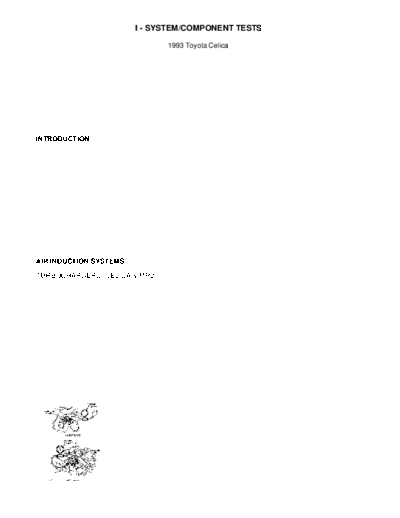Service Manuals, User Guides, Schematic Diagrams or docs for : . Car Manuals Toyota Celica 1988-1989.1993-1994.2000 Approved Toyota Celica 1993 SYSTEM_C
<< Back | HomeMost service manuals and schematics are PDF files, so You will need Adobre Acrobat Reader to view : Acrobat Download Some of the files are DjVu format. Readers and resources available here : DjVu Resources
For the compressed files, most common are zip and rar. Please, extract files with Your favorite compression software ( WinZip, WinRAR ... ) before viewing. If a document has multiple parts, You should download all, before extracting.
Good luck. Repair on Your own risk. Make sure You know what You are doing.
Image preview - the first page of the document

>> Download SYSTEM_C documenatation <<
Text preview - extract from the document
I - SYSTEM/COMPONENT TESTS
1993 Toyota Celica
1993 ENGINE PERFORMANCE
Toyota System & Component Testing
Celica
INTRODUCTION
Before testing separate components or systems, perform
procedures in F - BASIC TESTING article. Since many computer-
controlled and monitored components set a trouble code if they
malfunction, also perform procedures in G - TESTS W/CODES article.
NOTE: Testing individual components does not isolate shorts or
opens. Perform all voltage tests with a Digital
Volt-Ohmmeter (DVOM) with a minimum 10-megohm input
impedance, unless stated otherwise in test procedure. Use
ohmmeter to isolate wiring harness shorts or opens.
NOTE: When testing some systems, tachometer may be required.
Tachometer must be connected to proper terminals. For
tachometer connections, see IDLE SPEED & MIXTURE in
D - ADJUSTMENTS article.
AIR INDUCTION SYSTEMS
TURBOCHARGERS (CELICA & MR2)
Initial Checks
1) Check air intake system for cracks or restrictions.
Inspect exhaust system for leaks or restrictions.
2) Check air intake system and exhaust system for signs of
oil leaks from turbocharger. Oil leaks can be caused by worn oil seals
in turbocharger.
Wastegate Actuator
1) Disconnect hose from wastegate actuator. Using Pressure
Gauge/Pump (SST 09992-00241), apply approximately 9.4 psi (.66 kg/cm )
of pressure to wastegate actuator. See Fig. 1. Ensure wastegate
actuator rod moves.
2) Replace turbocharger assembly if wastegate actuator rod
does not move. Remove pressure gauge/pump and reconnect hose.
CAUTION: DO NOT apply more than 11.4 psi (.8 kg/cm ) pressure to
wastegate actuator.
Fig. 1: Checking Wastegate Actuator (Turbo)
Courtesy of Toyota Motor Sales, U.S.A., Inc.
NOTE: Turbo pressure may be referred to as boost pressure.
Tachometer is required when checking turbo pressure. If
installing tachometer, ensure it is connected to proper
terminals. For tachometer connections, see IDLE SPEED &
MIXTURE in D - ADJUSTMENTS article.
Turbo Pressure Check
1) Ensure intake air hoses are connected. Install hose, "T"
fitting and pressure gauge between intake manifold and turbocharging
pressure sensor. See Fig. 2.
2) Drive vehicle with engine at 2800 RPM or more with
throttle fully open and transaxle in 2nd gear (Celica) or 3rd gear
(MR2), and note turbo pressure. Turbo pressure should be 7.1-11.8 psi
(.50-.83kg/cm ).
3) If turbo pressure is less than specified, check intake air
and exhaust systems for leaks. If no leaks exist, replace
turbocharger. If turbo pressure exceeds specification, check wastegate
actuator hose for leaks or cracks. If no leaks or cracks exist,
replace turbocharger. Remove test equipment.
NOTE: Ensure turbocharging pressure sensor and vacuum switching
valve are okay. For testing procedures, see ENGINE SENSORS &
SWITCHES.
Impeller Wheel Rotation
Disconnect air cleaner hose. Rotate impeller wheel in air
intake side of turbocharger and verify smooth rotation. Replace
turbocharger if impeller wheel binds, drags or does not rotate
smoothly.
Turbine Shaft End Play & Radial Play
1) Disconnect intake and exhaust hoses and pipes from
turbocharger. Disconnect oil drain tube from turbocharger.
2) Install dial indicator with stem resting against end of
shaft on impeller wheel (intake side). Push turbine wheel (exhaust)
side of shaft toward dial indicator and zero dial indicator. Push
impeller wheel (intake side) away from dial indicator, and note end
play reading on dial indicator.
3) Remove dial indicator and reinstall with stem extending
into oil drain tube hole and against center of turbine shaft. Pull
impeller wheel (intake side) and turbine wheel upward toward dial
indicator and zero dial indicator.
4) Push impeller wheel and turbine wheel downward and note
radial play reading on dial indicator. Replace turbocharger if end
play or radial play exceeds specification. See TURBOCHARGER
SPECIFICATIONS table. Reinstall oil drain tube, intake and exhaust
hoses, and pipes.
TURBOCHARGER SPECIFICATIONS TABLE
◦ Jabse Service Manual Search 2024 ◦ Jabse Pravopis ◦ onTap.bg ◦ Other service manual resources online : Fixya ◦ eServiceinfo